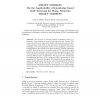Free Online Productivity Tools
i2Speak
i2Symbol
i2OCR
iTex2Img
iWeb2Print
iWeb2Shot
i2Type
iPdf2Split
iPdf2Merge
i2Bopomofo
i2Arabic
i2Style
i2Image
i2PDF
iLatex2Rtf
Sci2ools
NETWORKING
2008
2008
On the Applicability of Knowledge Based NAT-Traversal for Home Networks
The presence of Network Address Translation (NAT) is a hindrance when accessing services within home networks, because NAT breaks the end-to-end connectivity model of the Internet protocol suite. Communication across NATs is only possible if it is initiated from a host belonging to the internal network. Thus, services expecting a connection established from the outside fail in most situations. Existing approaches for NAT-Traversal do not cover the full range of NAT-Traversal methods and fail in certain situations, or deliver sub optimal results in others. Part of the problem of existing approaches is that they do not differentiate between different types of applications. We argue that the classification of applications into four service categories helps to determine the best matching NAT-Traversal technique. An extensive field test enables us to acquire knowledge about the success rates of promising NAT-Traversal techniques. These results will help us to develop a knowledge driven NAT-...
Computer Networks | End-to-end Connectivity Model | Nat Behavior | Network Address Translation | NETWORKING 2008 |
| Added | 29 Oct 2010 |
| Updated | 29 Oct 2010 |
| Type | Conference |
| Year | 2008 |
| Where | NETWORKING |
| Authors | Andreas Müller, Andreas Klenk, Georg Carle |
Comments (0)

